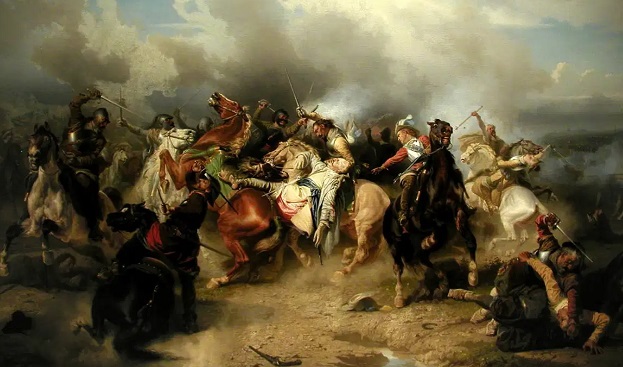
Germany in the early 1600s was a mosaic of duchies, bishoprics, and free cities – all held loosely together within the Holy Roman Empire. But underneath that fragile peace simmered deep divisions: Catholic vs. Protestant, emperor vs. princes, and local power vs. foreign ambition.
When these tensions erupted in 1618, they unleashed one of the most destructive conflicts in European history – the Thirty Years’ War. Lasting from 1618 to 1648, it ravaged Germany, decimated its population, and redefined the map and balance of power across the continent.
Let’s explore how this war began, how it unfolded, and why its impact on Germany was so profound and long-lasting.
Causes: A Powder Keg of Religion and Politics
The roots of the conflict go back to the Protestant Reformation and the uneasy peace established by the Peace of Augsburg (1555). This treaty allowed rulers to choose their territory’s religion – but it excluded Calvinists, who had grown in number and influence.
Other key tensions included:
- Religious fragmentation: Protestant and Catholic states distrusted each other.
- Imperial ambitions: The Habsburg emperors wanted to consolidate control.
- Foreign interference: France, Spain, Sweden, and others eyed opportunities to expand power.
The spark came in Bohemia, where Protestant nobles revolted against the Catholic Habsburg emperor. They famously threw imperial envoys out a window in the Defenestration of Prague (1618) – a dramatic gesture that ignited war.
The Four Phases of the War
Historians often divide the war into four overlapping phases:
1. The Bohemian Phase (1618–1625)
- Protestant nobles in Bohemia rejected Habsburg rule and offered their crown to Frederick V of the Palatinate.
- Habsburg forces crushed the revolt at the Battle of White Mountain (1620).
- Catholic victory led to harsh repression in Bohemia.
2. The Danish Phase (1625–1629)
- King Christian IV of Denmark, a Protestant ruler, intervened to support northern German Protestants.
- He was defeated by Albrecht von Wallenstein, the emperor’s brilliant general.
- The Edict of Restitution (1629) sought to restore Catholic Church lands – fueling Protestant outrage.
3. The Swedish Phase (1630–1635)
- Gustavus Adolphus of Sweden entered the war as a Protestant champion.
- Swedish victories at Breitenfeld and Lützen turned the tide.
- Gustavus died in battle in 1632, and the momentum slowed.
4. The French Phase (1635–1648)
- Catholic France, fearing Habsburg dominance, joined the war on the Protestant side.
- Fighting shifted focus from religion to geopolitics.
- The war became increasingly destructive, especially for civilians.
Germany’s Devastation
The Thirty Years’ War devastated German lands more than any other part of Europe:
- An estimated 20–40% of the population died from war, famine, or disease.
- Cities were sacked, villages burned, and farms abandoned.
- Trade collapsed, inflation soared, and lawlessness spread.
The war saw the rise of mercenary armies – unpaid and undisciplined soldiers who lived off the land, plundering wherever they went.
Cultural trauma ran deep:
- Art and literature from the time reflect despair and chaos.
- The memory of the war shaped German identity for generations.
The Peace of Westphalia (1648)
After years of negotiation, the war ended with the Peace of Westphalia in 1648:
- Religious tolerance was expanded: rulers could choose Catholicism, Lutheranism, or Calvinism.
- Territorial sovereignty was confirmed – German princes gained greater independence from the emperor.
- France and Sweden gained land and influence.
- The Holy Roman Empire became even more fragmented – now over 300 autonomous entities.
Westphalia is often cited as the beginning of the modern international system, emphasizing the sovereignty of states.
Long-Term Impact on Germany
The war’s scars were deep and enduring:
- Population loss set back economic and demographic growth for generations.
- Political fragmentation persisted until the 19th century.
- The Holy Roman Empire lost prestige and coherence.
- Religious tolerance grew in law, but social divisions remained.
Yet in some ways, the war forced Germany to adapt:
- Some cities and regions reformed their governance and infrastructure.
- Intellectual life slowly recovered, setting the stage for the German Enlightenment.
The Thirty Years’ War was not just a German tragedy—it was a European turning point. For Germany, it marked the collapse of old certainties and the beginning of a new, more fragmented reality. Faith, empire, and ambition collided—and the result was devastation, but also transformation.
To explore more, see The Peace of Westphalia (1648), Martin Luther and the 95 Theses, or discover how Germany began to rebuild in The Enlightenment in the German States.
